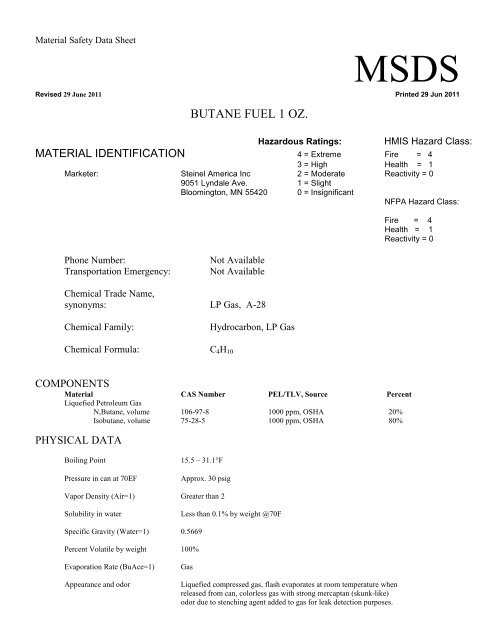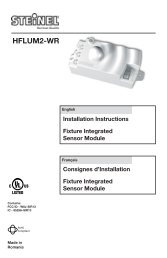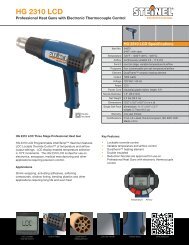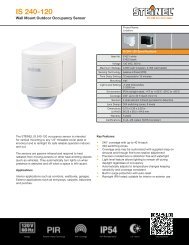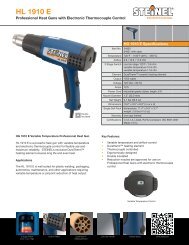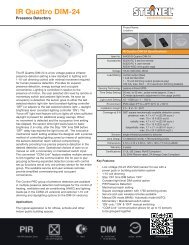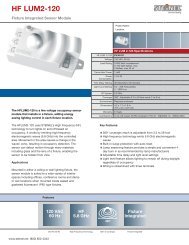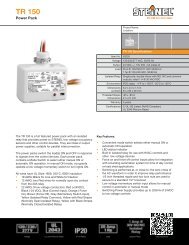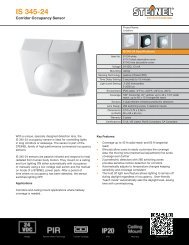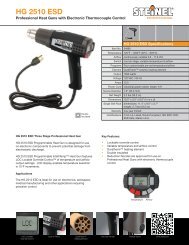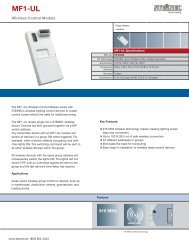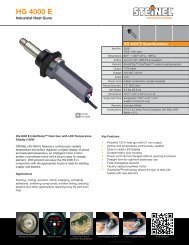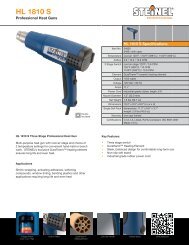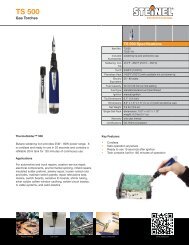BUTANE FUEL 1 OZ. - STEINEL
BUTANE FUEL 1 OZ. - STEINEL
BUTANE FUEL 1 OZ. - STEINEL
You also want an ePaper? Increase the reach of your titles
YUMPU automatically turns print PDFs into web optimized ePapers that Google loves.
Material Safety Data Sheet<br />
MSDS<br />
Revised 29 June 2011 Printed 29 Jun 2011<br />
<strong>BUTANE</strong> <strong>FUEL</strong> 1 <strong>OZ</strong>.<br />
Hazardous Ratings:<br />
HMIS Hazard Class:<br />
MATERIAL IDENTIFICATION 4 = Extreme Fire = 4<br />
3 = High Health = 1<br />
Marketer: Steinel America Inc 2 = Moderate Reactivity = 0<br />
9051 Lyndale Ave. 1 = Slight<br />
Bloomington, MN 55420 0 = Insignificant<br />
NFPA Hazard Class:<br />
Fire = 4<br />
Health = 1<br />
Reactivity = 0<br />
Phone Number:<br />
Transportation Emergency:<br />
Not Available<br />
Not Available<br />
Chemical Trade Name,<br />
synonyms: LP Gas, A-28<br />
Chemical Family:<br />
Hydrocarbon, LP Gas<br />
Chemical Formula: C 4 H 10<br />
COMPONENTS<br />
Material CAS Number PEL/TLV, Source Percent<br />
Liquefied Petroleum Gas<br />
N,Butane, volume 106-97-8 1000 ppm, OSHA 20%<br />
Isobutane, volume 75-28-5 1000 ppm, OSHA 80%<br />
PHYSICAL DATA<br />
Boiling Point<br />
Pressure in can at 70ΕF<br />
15.5 – 31.1°F<br />
Approx. 30 psig<br />
Vapor Density (Air=1) Greater than 2<br />
Solubility in water<br />
Less than 0.1% by weight @70F<br />
Specific Gravity (Water=1) 0.5669<br />
Percent Volatile by weight 100%<br />
Evaporation Rate (BuAce=1)<br />
Appearance and odor<br />
Gas<br />
Liquefied compressed gas, flash evaporates at room temperature when<br />
released from can, colorless gas with strong mercaptan (skunk-like)<br />
odor due to stenching agent added to gas for leak detection purposes.
HAZARDOUS REACTIVITY<br />
Stability<br />
Stable when stored as a liquid in cans under its own pressure.<br />
Conditions to avoid<br />
Contact with sparks, open flame or any source of ignition.<br />
Hazardous Polymerization<br />
Hazardous Decomposition<br />
Products<br />
Will not occur<br />
May produce carbon monoxide when oxidized with deficiency of oxygen.<br />
FIRE AND EXPLOSION DATA<br />
Flammability Category<br />
Flash Point<br />
Extremely Flammable (Reference - Consumer Product Commission, flame projection<br />
test for aerosol products, per 16 CFR 1500.45)<br />
Less than -117ºF<br />
Flammable Limits LEL% 1.8 UEL% 8.5<br />
Extinguishing Media<br />
Unusual Fire and<br />
Explosion Hazards<br />
If feasible, stop flow of gas. Use water to cool fire-exposed cans, surroundings and<br />
to protect personnel working on shut off. Water spray, dry powder or carbon dioxide<br />
can be directed at flame area, if gas flow cannot be stopped, to reduce fire intensity.<br />
DO NOT COMPLETELY EXTINGUISH FLAME UNLESS GAS FLOW IS SHUT<br />
OFF!<br />
This product presents an extreme fire hazard. Liquid very quickly evaporates, even at<br />
low temperatures, and forms vapor (fumes) which can catch fire and burn with<br />
explosive violence. Invisible vapor spreads easily and can be set on fire by many<br />
sources such as pilot lights, welding equipment, and electrical motors and switches.<br />
For fires involving this material, do not enter any enclosed or confined fire space<br />
without proper protective equipment. This may include self-contained breathing<br />
Apparatus against the hazardous effects of normal products of combustion of oxygen<br />
deficiency. Petroleum gases are heavier than air and travel along the ground or into<br />
drains to possible distant ignition sources, causing an explosive flashback.<br />
Special Fire Fighting<br />
Procedures<br />
Avoid possible accumulations of vapors at floor level, as vapor is heavier than<br />
air. Self-contained breathing apparatus and protective clothing should be worn<br />
in fighting fires involving chemicals.<br />
This product is extremely flammable at all times. Keep away from any sources<br />
of inadvertent ignition, including heat, fire, sparks, or flame.<br />
2
HEALTH HAZARD INFORMATION<br />
Suggested Exposure Guideline<br />
Primary Route of Exposure<br />
Inhalation<br />
Skin Contact<br />
Eye Contact<br />
Carcinogenicity<br />
1000 ppm<br />
Inhalation, skin contact, eye contact<br />
This product is an asphyxiate and may exhibit anesthetic properties at very high<br />
concentrations. Initial symptoms of exposure at these concentrations are disorentation,<br />
lack of coordination, rapid respiration, headache, and nausea. Continued exposure<br />
May result in unconsciousness, coma, and possible death.<br />
Vapors are not irritating. Freeze burns or frostbite possible if skin is in<br />
prolonged contact with vaporizing liquid.<br />
Same as skin contact.<br />
None of the components in this material are listed by IARC, NTP, OSHA, or<br />
ACGIH as a carcinogen.<br />
FIRST AID<br />
Inhalation<br />
Skin Contact<br />
Eye Contact<br />
Ingestion<br />
Remove to fresh air. Artificial respiration, consult physician.<br />
Wash with soap and water. Remove soaked clothing to avoid prolonged skin<br />
contact.<br />
Flush eyes well with running water for 15 minutes.<br />
NA, product is gaseous at normal temperature and pressure.<br />
SPILL OR LEAK PROCEDURES<br />
Steps to be taken in<br />
case material is released<br />
or spilled<br />
Protect from any ignition source, keep away from heat, fire, sparks, or flame.<br />
Ventilate area well. Avoid accumulation of vapor at low levels.<br />
Waste disposal method<br />
Dispose of in accordance with all local, state and federal<br />
regulations. Do not puncture or incinerate.<br />
SPECIAL PROTECTION INFORMATION<br />
Respiration Protection<br />
Ventilation<br />
Protective gloves<br />
Eye Protection<br />
If TLV is exceeded wear NIOSH-approved self-contained breathing<br />
device or respirator.<br />
Must be adequate to maintaining airborne concentrations below established exposure<br />
limits, particularly at floor level as vapors are heavier than air.<br />
None needed for normal use. Thermal insulated gloves when handling<br />
if prolonged exposure expected.<br />
Safety glasses or goggles recommended<br />
3
HANDLING AND STORAGE PRECAUTIONS<br />
Precautions to be taken<br />
in handling and storage<br />
D.O.T. Shipping<br />
Classification<br />
Hazard Class<br />
ID Number<br />
Label Required<br />
Do not store where temperature may exceed 120ΕF. Store away from, fire,<br />
sparks, or flame. Store in suitable area for hazardous materials storage.<br />
Consumer Commodity, ORM-D<br />
None<br />
None<br />
Carton must be marked: Consumer Commodity, ORM-D<br />
TSCA Statement: All the components of this product are in compliance with the Toxic Substances<br />
Control Act (TSCA) and are either listed on the TSCA Inventory or otherwise exempted from<br />
listing.<br />
SPECIAL PRECAUTIONS<br />
Precautions for usage<br />
Do not use near heat, fire, flame or sparks. Avoid excessive<br />
breathing of vapor. Do not spray in direction of body. Use only<br />
in accordance with directions.<br />
Notice: This data represents typical values, not product specifications. No guarantee of accuracy or completeness is<br />
made. No responsibility is assumed for any kind of loss or damages arising from use of this data.<br />
End of MSDS<br />
4


